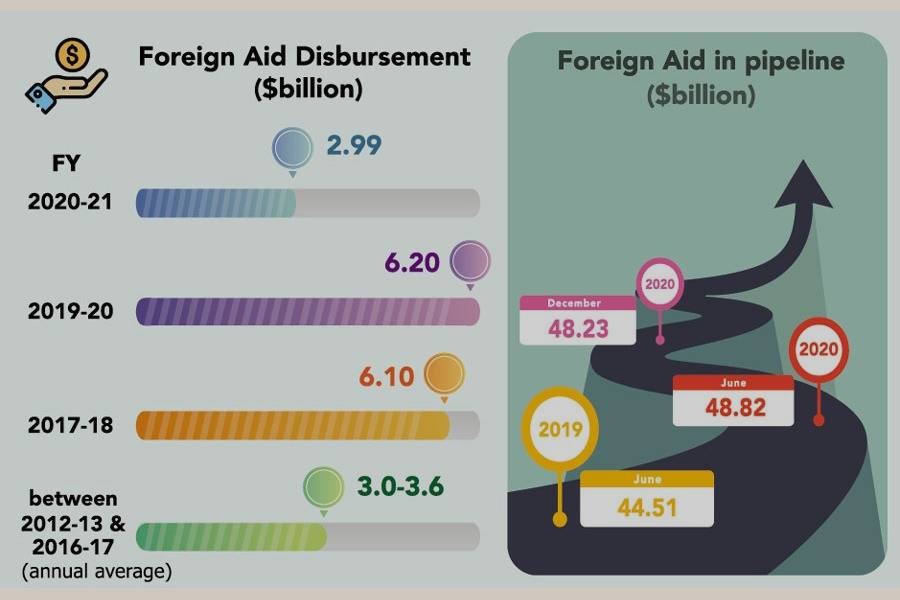The volume of undisbursed project aid (PA) ballooned to more than US$48 billion until December last, as many public agencies failed to utilise the same, officials said on Monday.
The amount is more than enough to bankroll the annual development programme of the country for two years. The revised ADP for the year 2019-20 was worth US$23 billion.
The volume of aid in the pipeline has been rising for the past decades. The failure of the state agencies to use the aid money within the stipulated time is largely responsible for the aid pipeline bulging constantly, said a senior official of the Economic Relations Division (ERD).
The foreign aid is usually provided as medium and long-term (MLT) loans and grants by the development partners, including the World Bank (WB), the Asian Development Bank, the Islamic Development Bank, Japan and China.
The ERD data showed that the undisbursed foreign aid at the end of financial year (FY) 2019-20 was at $48.82 billion.
At the end of the last FY, fresh commitments amounted to $9.8 billion and $6.2 billion worth of assistance, the highest ever, was utilised. Yet the amount fell short of the spending target of $7.5 billion set for the year, the ERD statistics showed.
The ERD official said the size of the undisbursed external fund reduced slightly in July-December period (H1) of the current FY, 2020-21, as the aid disbursement was higher than the commitment.
According to the ERD, the development partners disbursed $2.99 billion worth of aid in H1 of FY 21, while the total commitment was $2.40 billion during the period.
So, the total unutilised aid in the pipeline reduced to $48.23 billion as of December 2020.
"The main reason behind the sizeable volume of aid remaining undisbursed is the failure of the government agencies to use it in time. The fund utilisation capacity of these agencies has not been improving," said another senior official of the ERD.
"The ERD has been continuously taking various initiatives to ensure maximum utilisation of assistance earmarked for development projects. In recent years, quarterly tripartite portfolio meetings, at the wing-level, have been held with the ministries and divisions and the development partners."
"Moreover, there are biennial meetings at the secretary-level as well as annual meetings at the finance minister-level to review the progress of high-profile projects."
Apart from these initiatives, the progress of project implementation is monitored through a series of inspections, the official said.
Meanwhile, the unutilised foreign aid, including MLTs and grants in the pipeline, was recorded at $44.51 billion until FY 2019, the ERD data showed.
Between FY 2012-13 and FY 2016-17, the government managed to spend foreign aid ranging between $3.0 billion and $3.6 billion a year. In FY 2017-18, the spending went up to $6.1 billion.
The lenders, however, seem to be optimistic about Bangladesh, as is evident in the growing amount of foreign aid in the pipeline.
Dr Zahid Hussain, former lead economist of the WB, told the FE that execution of the foreign-funded projects picked a little pace in the H1 of the current FY. But it is still inadequate for expediting utilisation of the foreign funds.
The project implementation delay and incapability were the key reasons for the undisbursed aid, confirmed by different donors for disbursement, he added.
Dr Hussain identified some key reasons behind the setback in available aid utilisation, leading to rise in the aid in the pipeline. The reasons are - weakness in project preparation, faulty design, complex land acquisition and procurement system, and frequent transfer of the project-related manpower.
Kazi Shofiqul Azam, former secretary of the ERD, said the aid commitment surged significantly over the last few years, which also prompted increase in the external assistance.
Nevertheless, poor project implementation capacity of the public agencies was the main reason for the huge volume of funds in the pipeline, he added.
Before FY 2009-10, Bangladesh used to receive aid commitments between $1.0 billion and $2.0 billion a year. Since 2009-10, Bangladesh had been getting $5.0 billion a year. From FY 2015-16 onwards, the amount has been rising.
Russia alone made commitment to bankroll $11.38 billion funds for the Rooppur Nuclear Power Plant. The plant would take 10 years to implement, but all its loan agreements were signed within 12 months.


